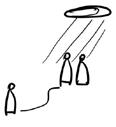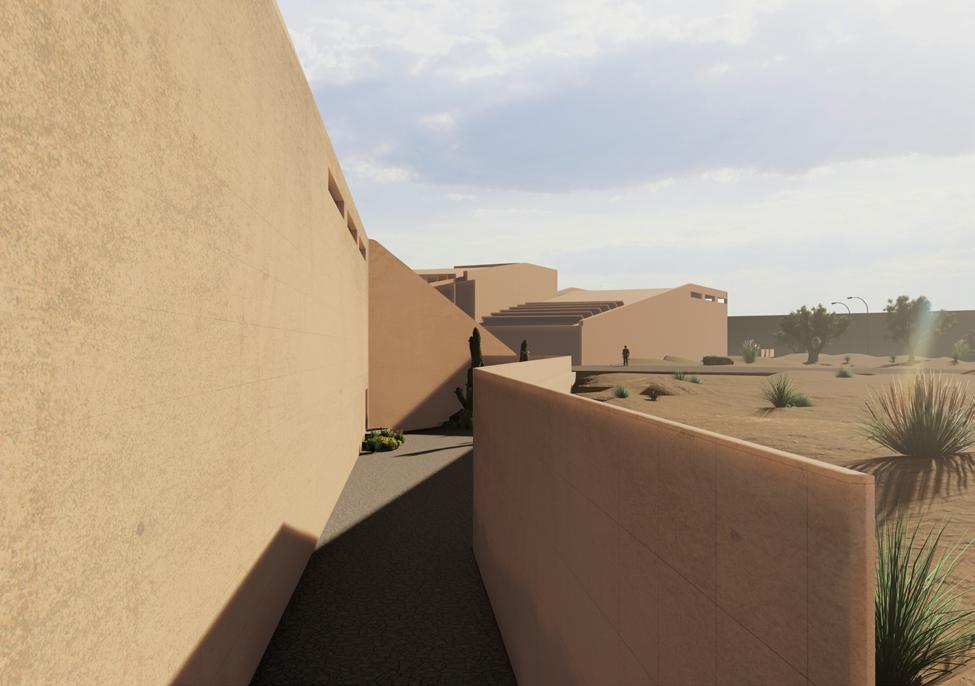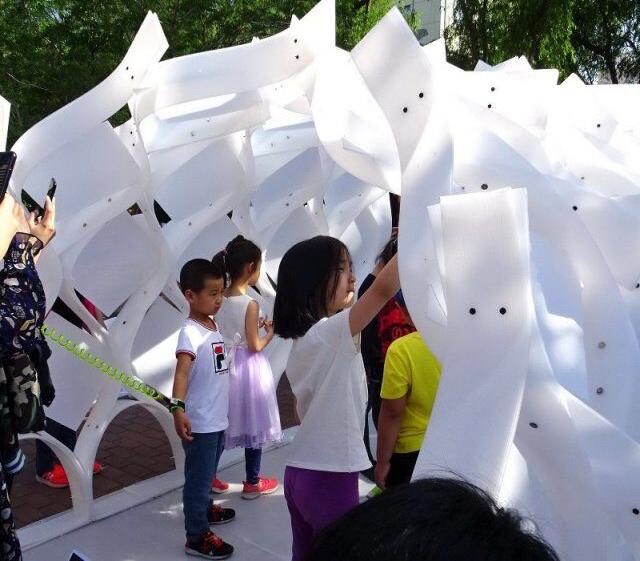PORTFOLIO
YU LI
B.Arch,Harbin Institute of Technology Selected works from 2018-2022

FINDING
CONTENTS

When I was walking down my neighborhood as a kid, I was always surrounded by series of boxliked buildings. Ever since then, I tend to perceive buildings as square boxes, whether it was a house, a library or a shopping mall, they all seemed to look the same. Because of that I was curious about why these repeated boxes can carry different functions.
By a chance, I learned that my hometown Tangshan experienced a severe earthquake in 1976, and these square boxes are modular buildings that were quickly rebuilt after the earthquake. I began to understand that those repetitive, boring square boxes do not only carry a single function, they can assume a more urban level of meaning.
Even a simple shape is not necessarily a simple building. I read a lot of books about architecture and urban development to explore more significance of architecture. Modernist architecture has a great influence on me. The social contradictions after the World War I pushed the modern Architectural Movement to a climax, resulting in many modernist buildings with simple shapes, just like square boxes. However, there are many revolutionary thinking and technological changes inside these sim ple boxes.
I tend to focus on more aspects of architecture in my design and trying to find more possibilities of architecture. In my “Urban Debris “design, I tried to extend the urban texture of Wuhan with scattered boxes to provide a common space for both local people and migrant work ers; In the theater design in Xinjiang ,I focus on the local environment and culture to fully integrate the building into the site. In the high-rise building design, I put some floating boxes into high-rise buildings as public spaces as well as supporting structures, in order to meet the needs of office in the future.
When I returned to my hometown and looked at these repetitive square boxes once again, I saw more possibility and vitality of space.
01 Urban Debris


A building that integrates two groups of people in Wuhan
Jul.-Aug. 2022
Individual Work Type: Studio Alpha Open Project 220
02 The Road To The West
Theatre design based on the stories of the Silk Road
Apr.-May. 2022
Individual Work Grade:4
03 Galaxy Office
Super high-rise design of office space in the future
Oct.-Dec. 2021 Individual Work Grade: 4
Other Works

Flowing Nature
Urban design in Harbin
Youth Entrepreneurship And Residential Complex
The "Guyu Cup" National College Students Sustainable Architecture Design Competition
Twinkling Stars
Building Design and Construction Competition
-01-
Urban debris
A building that integrates two groups of people in Wuhan
Jul.-Aug. 2022
Individual Work location: Wuhan,China
Source: Studio Alpha Open Project 220 insteuctor: Pan Junxuan (from Studio Alpha) Instructor’s Contact: alfredpun@gmail.com
A spliced city
The site is located in Wuhan, China. Wuhan is a city famous for its water culture, and its superior geographical conditions have made Wuhan one of the most important port cities in China since ancient times. At the same time, the developed economy made a large number of migrant workers poured into Wuhan. A large part of them come to Wuhan wharf to earn a living. This makes the population composition of Wuhan complex.
This plan selects two groups of people with different needs for water along the Yangtze River , trying to create a space for these two groups to use together.
There are two types of buildings in the site-- the bathing place and the wharf, serving two different groups along the river. There are also some buildings which can be used by all people, such as restaurants, exhibition halls.

Population Analysis :Two kinds of People On The Riverside
In the population analysis, it is found that there are mainly 2 kinds of people along the riv er. The local people in Wuhan like to play in the water, or taking a bath in the Yangtze River; The workers need to work in the riverside wharf or take a ferry to the work place.

Historical Background : Wuhan Culture Formed By Water
Wuhan's wharf culture can be traced back hundreds of years ago. Due to its superior geographical location, Wuhan has always been an important port city. Until several hundred years ago, when countries opened concessions, modern water transport began to develop, and a large number of people poured into Wuhan. Now, Wuhan has formed the status quo of coexistence of multiple docks, cultures and people.
Regional analysis:The Complex Urban Texture of Wuhan


Due to historical reasons, there are many buildings of different periods in Wuhan, forming a complex urban fabric like a city that is spliced together.
The site is located in Jianghan Park, Wuhan City. There are many ferry piers beside the site, and many residents are playing in the river.
Since people and buildings in Wuhan are very mixed, I want to follow the urban texture of Wuhan using the jigsaw puzzle as the concept. The dif ferent functions of the two groups in the architecture are suitable for their respective adaptation, so that they can coexist in one building

The building site is located in a park by the side of the river, which is sur rounded by two square and a viewing platform.there are also 2 ferry termi nals besides the site.
Site Analysis: Site On The Riverside
Forming Progress: Remove Debris From The Site
Based on the concept and location analysis, I cut different pieces of the site to make them scattered in the water as the space for workers,like Ferry terminal. The corresponding rest spaces as the leisure space for locals ,like bath or cruise ship dock.


STEP1 : adding a road
Adding a road to connect the square and the site,locating the ferry terminal on the end of the road where can easily access to the urban road.
STEP2: dropping
Take off one piece from the land section as Ferry terminal, the rest of it as bath.
STEP3: dropping more
Take off more pieces from the site as the bathes
STEP4: adjusting Adjusting the volume according to the function of use and the axis of the site




Function Analysis :Places For Different People In The Building
The site is distributed with buildings that can be used by two groups of people, and some buildings that can be used by all the people.
work both leisure route of ferry route of boat
Dock Park the cruise ship
Ferry terminal: 01.Ferry Staff Office 02.shop 03.Storage room 04.Ticketing Hall 05.hall Dock office: 06.Cruise Ticket Hall 07.storage: Sailor’s lounge: 08.dormitory 09.Shower
Bath: 10.swimming pool 11.Indoor bath 12.leisure bath 13.Dock 14.Island
Bath For people to swim
Ferry terminal Passengers can board here
Single Building Analysis: Relationship Between Architectural Form And Users


15.Coffee shop 16.exhibition 17.resturant 18.lavatory line circle square
shape
For work group
Ferry terminal Sailor's lounge Dock office
For leisure use
Boat pier Leisure bath Indoor bath
For all the people
Exhibition Coffee shop resturant
Ground Floor Plan

There are mainly three shapes in this scheme, which are used to meet the needs of different spaces. Based on the concept of "Falling Puzzle", buildings used by different people have shape correspond ence. 0m 5m 20m

Axonometric Diagram:People's Activity In The Building

Workers and locals can share these building Spaces. The people in blue are workers, the people in green are locals.
There are mainly three shapes in this scheme, which are used to meet the needs of different spaces.






-02-
The road to the west
Theatre design based on historical stories of the Silk Road
Apr.-May. 2022
Individual Work Grade:4 Location:Xinjiang ,China Course Name:Architecture Design 6 Insteuctor: Huang Meng Instructor’s Contact: hithm@126.com
The Silk Road
The Silk Road is a treasure hunting road. As early as a few hundred years ago, eminent monk Xuanzang set foot on the Silk Road alone to seek Buddhist scriptures in India. Along the way, he encountered various hardships and also met many interesting things.
The site is located in a town of Xinjiang, China ,which is surrounded by a desert. It is also one of the most important sites of the Silk Road.
This design selects the story of Xuanzang's journey and create different spaces for people to experience Xuanzang's treasure hunting experience. People can wounding between nature and architecture, just like walking in the desert.

A Long Way To Find The Treasure
The Silk Road originated in the Western Han Dynasty and reached its peak in the Tang Dynasty. Many different stories have been formed on the Silk Road. Xuanzang's journey to the west is a very impor tant one.After this juorney Xuanzang brought the Buddhist scriptures from India to China.
Story Line: What happened on Xuanzang's journey
Xuanzang met many obstacles as well as many enthusiastic people on his journey to the west.


Pamirs
Pamirs is located in the plateau, with many snow mountains and harsh cli mate
Dunhuang
Dunhuang is also located in a desert,It is said that there are many immortals there

Changan
in 629, Xuanzang decided to go to India to study Buddhism.
India
Xuanzang went to Nalando Temple, the most famous temple in Dharma Jietuo State, and devoted himself to cultivation.
天竺 Xinjiang(SITE)



Xinjiang located in northwest of China,and Surrounded by desert and plateau
Finding Xuanzang decided to go west alone
Lost The desert was heavily guarded.
Meet
The king of Gaochang treated Xuanzang warmly.
Site AnalysisⅠ : A Town Surrounded By Desert


敦煌 Liangzhou
Liangzhou is located in a desert,The weather here is bad and the popula tion is sparse.
insight

hope The king of Shaye city escorted Xuanzang to India
Pamirs Plateau had lay ers of snow mountains. But the destination is getting closer.
Destination he finally arrived at the Tianzhu Holy Land
The base is located in Xinyuan County, Xinjiang, and it is an important stop of the Silk Road. Xinyuan County is surrounded by deserts and mountains.
Site Analysis Ⅱ:Analysis Of Surroundings
The site is located in the corner of Xinyuan County, to the north of it there is lake. There are many houses around the site.
Surrounding buildings analysis

The surrounding buildings are mainly resi dential buildings and public buildings.
Form Developement
This design is based on the con cept of the Silk Road, and adopts a continuous form, as if it is a road going through the desert.


1.Determine the building trend accord ing to the site shape and pedestrian.
2.Reduce the building volume and cre ate two roads leading to the lake.

Traffic analysis
There is a small lake called Tiane Lake around the site. There are two traffic ar teries, a two lane highway and a pedestri an path nearby
Cultural Analysis:
Xinjiang has many nationalities living together, forming a unique composite culture.

Location in the town
The site is located at the corner of Xinyuan County .
Local Architecture Analysis:
The local buildings in Xinjiang are mainly made of sand and stone,some of them are built in the ground or on the hill. In addition, there are felt houses with nomadic characteristics.

3.Create accessible roofs and semi un derground courtyards.
4.Create skylight to introduce natural light.












Indoor Space: Going back to Xuanzang's journey to the west

The building has multiple circulations and multiple exits to the outside. Sometimes the roof, ground and indoor ground will intersect, allowing people to freely cross between indoor and outdoor. At the same time, people can feel different emotions through changes in light, shadow and space





hope
finding lost meet
Moving forward, there is a well lit and open hall ahead, which is the destina tion of the journey.




Walking from the bright hall to the un derground, the dark space makes us feel lost, but the light gives the hope.


Out of the small theater, the vision be comes wider, and the bright light and the rising stairs lead you to move on.


Entering through the side door, there is a bright room where many people gather to watch the performance
Keep moving, the road ahead is be coming crowded, and you can see some light in the distance.
The main entrance of the building, through which you can start to experi ence the way of treasure hunting .
Destination Theater Lounge hope One of the outlets insight Destination insight corridor Meet Medium theater Finding Entrance Lobby Lost Lobby-03-
Galaxy Office
Super high-rise design of office space in the future

Oct.-Dec. 2021
Individual Work Grade: 4 Location: Shanghai,China
Course Name: Architecture Design 5 Insteuctor: Yu Ge Instructor’s Contact: yuge_hit@yeah.net
Floating Boxes
In recent years, the office has become the most frequently used space for people,but the office space now has many drawbacks. The digital information age has put forward more requirements for office space. People are no longer satisfied with boring office space. However, they need more leisure space and shared space.
In this design, I put the floating box into the high-rise office building as a large public space, trying to weaken the space of "work" in the office building, so that more interesting events can occur in the office. This office is more like a free community.
At the same time, these boxes and some scattered columns constitute the structural system of the building together, replacing the traditional frame structure, making the standard floors become column free spaces for free layout, breaking the boundaries between layers.
Evolution Of Office Building: What was the office like over years

With the change of production mode, office building space is constantly changing. IIn 1900, intensive office space was the most popular. However, today's office space is more flexible.

1950
In the 1950s, the office advocated open and non partitioned office space, and all office furniture could be flexibly combined 1960
2020
Future
2010
1900
The typical office environment is full of hierarchical and impersonal colors, and standardized desks will be in tensively placed in open areas
The whole office space is effectively and perfectly managed by modular and grid space design.
1990
Co-workers want ed to become more integrated, and so a more sociable office layout was put into play.
The digital era has ushered in a new style of office that sees homely designs (even including beds, occasionally) mixed with excur sions into sheer grandeur in order to have workers feeling comfortable
Under the in fluence of the COVID-19 in 2020, many office work ers began to work at home, and the office environ ment seemed more free and diverse
With the improve ment of produc tion efficiency, of fice workers have more free time. The new office space should be more flexible.
Site Analysis: Diverse Office Population

Shanghai is a city with a large number of young population. People working in a wide variety of jobs such as Technology jobs, media jobs and art design jobs. The site is located in Pudong New Area, Shanghai, with many office buildings around.
Proportion of people with different occupations:

43% 38% 15%
43% of young people work in technology companies.
39% of young people work for media companies.
15% of young people work for design companies.
Concept: Floating Public Space
SITE
Office buildings within a five kilometre radius of the site
Inspired by the Milky Way, I want to insert some boxes into the building as a large space for public activities. At the same time, these boxes will work together with the columns as the structure for the building, creating flexible spaces without column frames.
STEP1: put public places into boxes
Museum Theater Lounge
New Demand For Future Office Space: Flexibility,
And Sharing
In the future, office work will become more cooperative, and people of different occu pations can work together

The new office needs to meet the social needs of office workers, so that the cooper ation between workers will be more harmo nious.
Overcrowded office space makes office workers have no privacy, and the new of fice building needs more open space.
The traditional structure depresses the mo notony of the office, and new structures are needed to break the barriers between layers
Traditional office buildings generally lack rest space, and new office buildings need more rest space for office workers.
15° 30° 60°
Put different public space into boxes according to the tilt angles

STEP2: Combine the box and column as structure

+
use boxes as “beam” put in some columns structure








STEP3: Placed in boxes as public space
+ Traffic space galaxy office
Function Analysis of public spaces


The large spaces formed by the boxes can carry different functions, such as gyms, libraries, pavil ions. The boxes and the columns form the structure of the high-rise building together.





Leisure space Cinema
Exhibition
The exhibition can be used to display some of the design company’s artwork.
Library
There are leisure books and professional books in the library for office workers to read.
Theater
Leisure space
The leisure space is composed of different small spaces, which can be used as the rest room, video room, etc
Resturant
Used as staff canteen or communal kitchen.

Auditorium
The Auditorium can be used for hold press con ferences or large conferences.
Leisure space
Gym
The gym can be used for sports with small space requirements like table tennis and running.
Plan Of Different Functions: Commercial Space And Different Office Spaces








The building has four main functions, namely the first floor commercial space and exhibition space,media office,technology office and design office
01.Entrance
02.Information 03.Locker 04.Cashier 05.Exhibition 06.Store 07.Core-tube
interior space:
Plan of standard floor:Different office modes with no column
01.Library 02.Entertainment Room 03.Open office area 04.Meeting room

0m 2.5m 10m
19f Plan: Technology office
Stairs connect different floors, allowing people to communicate freely. Workers can enter the leisure room near by.
21f Plan: Design Office




Designers can communicate freely on the long table and easily enter the exhibition space.
Technology office: f13-f23
13f Plan:Technology office

01.Exhibition 02.Cafe 03.Team office area 04.Open office area 05.Core-tube
0m 2.5m 10m
Design Office: f23-f33

27f Plan:Design office

Space in the box: Activity Space With Different Functions

















